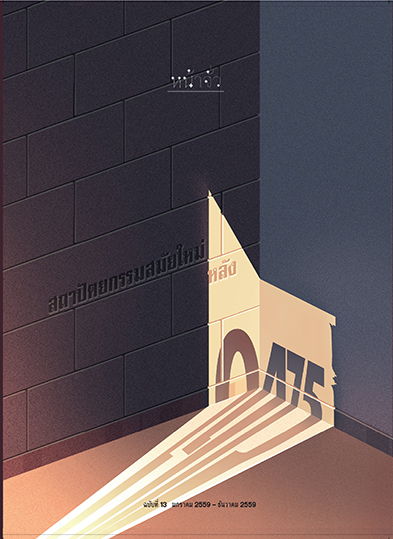การศึกษาพัฒนาการทางประวัติศาสตร์ของ “ผังเมืองลำปาง” สมัยใหม่ (พ.ศ. 2442-2557) กรณีศึกษาเขตผังเมืองรวมจังหวัดลำปาง/ The Study of the History of Lampang Urban Planning in Modern Era (2442-2557 B.E.), Case Study in Lampang Urban Region
Main Article Content
Abstract
บทคัดย่อ
งานวิจัยนี้มีจุดประสงค์ 2 ประการ ประการแรกคือเพื่อศึกษาความเปลี่ยนแปลงทางประวัติศาสตร์เกี่ยวกับผังเมืองลำปางในยุคสมัยใหม่ ประการที่สองคือ เพื่อหาความสัมพันธ์เชิงอำนาจระหว่างปฏิบัติการผังเมือง และการบริหารจัดการพื้นที่เมืองเชิงนโยบายและในเชิงปฏิบัติในบริบททางประวัติศาสตร์ของในเขตผังเมืองลำปาง งานวิจัยนี้เป็นงานวิจัยเชิงคุณภาพที่ใช้แนวพินิจทางประวัติศาสตร์ (Historical approach) ผ่านเอกสารร่วมสมัยและการสัมภาษณ์บุคคลที่อยู่ในช่วงเวลาตั้งแต่ พ.ศ. 2442-2557
ผลการศึกษาประการแรกพบว่า ในระยะเวลากว่า 100 ปี การจัดการเกี่ยวกับพื้นที่เมืองลำปางเปลี่ยนแปลงพร้อมกับความทันสมัย (Modernity) ที่เปลี่ยนแปลงกิจกรรมและการใช้ที่ดินของเมืองในปัจจัยที่แตกต่างกันไป โดยมีจุดเปลี่ยนสำคัญอยู่ 3 ประการนั่นคือ การมาถึงของรถไฟในปี 2459 ที่ทำให้เกิดย่านเมืองใหม่ทางทิศตะวันตกเฉียงใต้ของเมือง, การจัดตั้งเทศบาลเมืองลำปางในปี 2478 ที่ทำให้อำนาจท้องถิ่นสามารถจัดการพื้นที่เมืองของตนเองได้ และสุดท้ายคือการประกาศเขตผังเมืองรวมในปี 2533 ที่ทำให้การจัดการพื้นที่เมืองถูกรวมศูนย์กลับไปที่ส่วนกลาง พร้อมกับอำนาจการครอบงำของผู้เชี่ยวชาญเฉพาะด้าน ในประการที่สองพบว่า การบริหารจัดการพื้นที่เมืองแยกไม่ออกจากอำนาจทางการเมืองและเศรษฐกิจ โครงสร้างการเมืองที่รวมศูนย์ ไม่เป็นประชาธิปไตยและขาดเสถียรภาพ ย่อมส่งผลกระทบต่อนโยบายและความต่อเนื่องในการจัดการพื้นที่เมือง เมื่อพระราชบัญญัติการผังเมือง พ.ศ. 2518 ได้รวบรวมอำนาจการจัดการเกี่ยวกับผังเมืองกลับไปอยู่ในมือข้าราชการกระทรวงมหาดไทยและผู้เชี่ยวชาญ ทั้งยังมีขอบเขตที่เหลื่อมซ้อนกับหลายองค์กรปกครองส่วนท้องถิ่น การรวมศูนย์ทำให้การตัดสินใจและปฏิบัติการผังเมืองล่าช้า ทั้งยังขาดประสิทธิภาพ จนทำให้การบริหารจัดการเมืองแยกขาดออกจากปฏิบัติการผังเมืองไปในที่สุด
Abstract
This research focuses on two purposes : first, the historical change of Lampang Urban Planning, and, second, the power relations between the practice of town planning and the management of city area by policy and action in historical context. Drawing upon contemporary documents and the interview of people who participated in 1899-2013 A.D., this qualitative historical research found that, firstly, over a century the management of Lampang city had been changed by Modernity from the city's activities and land use in several factors. There are 3 turning points that have caused the change of Lampang city: first, the opening of Lampang train station and railway transportation in 1916 that had caused expansion of the city at its southwest side; second, the establishment of Lampang municipality in 1935 that decentralized the power to the people to govern themselves and manage their city; and, third, the making of Lampang Comprehensive plan in 1990 that re-centralized the power of city management back to the government and the expert of urban planning discipline. The second finding of this study is that the management of city could not be separated from politics and economy. The political structure that had been centralized with long term undemocratic government and lack of stability affected the policy and continuity of the city management. Town planning acts in 1975 grasped back the authority of planning to the government and the expert of town planning. The town planning territory of Lampang comprehensive plan had also been overlapped by the several municipalities. The centralization caused late decision, making action of town planning less effective. As a result, the management of Lampang city had been disintegrated from the action of town planning practice.


